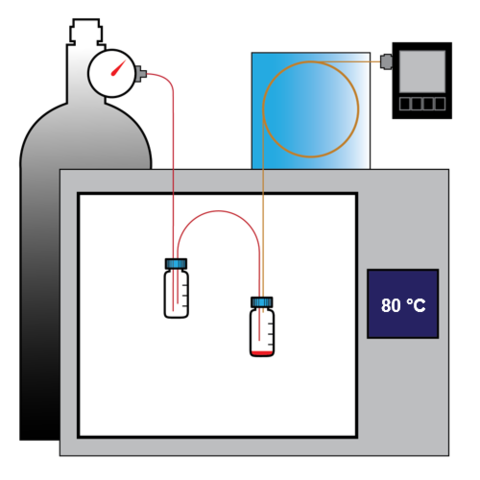Summary
We develop and evaluate dynamic headspace sampling methods to capture and concentrate vapors from single components (solid or liquid) to determine vapor pressures. These measurements provide high-quality data for process models. We also capture and analyze headspace vapor from complex, multicomponent matrices to provide information for forensic science applications.
Description

Vapor pressures of unstable, reactive compounds. Over the last decade, our group has investigated a variety of low-volatility compounds including taggants (found in explosives), biofuels, terpenes and cannabinoids. Dynamic vapor microextraction (DVME), developed at NIST, is a small-volume dynamic headspace method similar to purge-and-trap methods. This rapid method for large molecules achieves state-of-the-art measurement uncertainty for vapor pressures near 1 Pa. Our current focus on cannabis constituents provides some of the necessary measurement science for the development of a cannabis breathalyzer. This effort is funded in part by an interagency agreement with the National Institute of Justice and by the NIST Forensic Science Research Program.
Selected publications:
M. E. Harries*, C. N. Beuning*, B. L. Johnston, T. M. Lovestead, and J. A. Widegren, 2020 (*equal contribution). Rapid vapor collection method for vapor pressure measurements of low-volatility compounds, Analytical Chemistry 92, 16253-16259, https://doi.org/10.1021/acs.analchem.0c04131
T. M. Lovestead and T. J. Bruno, 2017. Determination of cannabinoid vapor pressures to aid in vapor phase detection of intoxication, Forensic Chemistry 5, 79-85, https://doi.org/10.1016/j.forc.2017.06.003.
J. A. Widegren, C. E. Beall, A. E. Tolbert, T. M. Lovestead and T. J. Bruno, 2016. The use of antioxidants to improve vapor pressure measurements on compounds with oxidative instability: methyl oleate with tert-butylhydroquinone. Journal of Chemical & Engineering Data 62, 539-546, https://doi.org/10.1021/acs.jced.6b00821.
J. A. Widegren, A. H. Harvey, M. O. McLinden, and T. J. Bruno, 2015. Vapor pressure measurements by the gas saturation method: the influence of carrier gas. Journal of Chemical & Engineering Data 60, 1173 - 1180, https://doi.org/10.1021/je500865j.
J. A. Widegren and T. J. Bruno, 2010. Vapor pressure measurements on low-volatility terpenoid compounds by the concatenated gas saturation method. Environmental Science & Technology 44, 388-393, https://doi.org/10.1021/es9026216.
Fire debris analysis.When arson is suspected at the scene of a fire, burned debris is collected and returned to the lab to be analyzed for residues of ignitable liquids (fuels) that may have played a role in the fire. Headspace concentration methods provide many advantages for the chemical analysis of forensic evidence. They provide a clean sample for instrumental analysis, do not require direct contact with potentially dangerous materials, are non-invasive, and can be non-destructive. Carbon adsorbent based methods require carbon disulfide, a neurotoxic solvent, whereas dynamic vapor microextraction (DVME) can recover ignitable liquid compounds with a relatively benign solvent: acetone. Our current focus is to quantitatively compare dynamic and passive headspace concentration methods to assess the practical potential of our method. This effort is funded in part by an interagency agreement with the National Institute of Justice and by the NIST Forensic Science Research Program.
Selected publications:
J. L. Berry*, M. E. Gregg*, A. A. Koepke, R. Newman, and K. M. Jeerage (*equal contribution). Concentration of ignitable liquid residue from simulated fire debris by dynamic vapor microextraction: sensitivity to instrument settings and debris characteristics, submitted.
J. L. Berry, M. E. Gregg, A. J. Friss, A. A. Koepke, C. L. Suiter, R. Newman, M. E. Harries, and K. M. Jeerage, 2022. Dynamic vapor microextraction of ignitable liquid from two realistic casework containers. Forensic Science International 336, 111315, https://doi.org/10.1016/j.forsciint.2022.111315
M. E. Harries, S. S. Wasserman, J. L. Berry, and K. M. Jeerage, 2021. Characterization of a headspace sampling method with a five-component diesel fuel surrogate. Forensic Chemistry 22, 100301, https://doi.org/10.1016/j.forc.2020.100301
J. E. Nichols, M. E. Harries, T. M. Lovestead, and T. J. Bruno, 2014. Analysis of arson fire debris by low temperature dynamic headspace adsorption porous layer open tubular columns, Journal of Chromatography A 1334, 126-138, https://doi.org/10.1016/j.chroma.2014.01.080.
T. J. Bruno, T. M. Lovestead, and M. L. Huber, 2011. Prediction and preliminary standardization of fire debris analysis constituents with the advanced distillation curve method, Journal of Forensic Sciences 56, S191-S202, https://doi.org/10.1111/j.1556-4029.2010.01628.x
Identification of headspace compounds from other complex matrices. Beyond vapor pressure measurements and forensic fire debris analysis, we have used our vapor sampling methods qualitatively to characterize the headspace compounds found in other complex, real-world samples that are significant for public health and safety reasons: explosives, spoiled food, and cadavers. These studies include both laboratory investigations and simulated field investigations with developing portable instruments.
Selected publications:
A. J. Friss, M. E. Harries, T. M. Lovestead, Portable Dynamic Vapor Microextraction, U.S. Patent Application 17/687,155, 2022
M. E. Harries and K. M. Jeerage, 2021. Preservation of vapor samples on adsorbent alumina capillaries and implications for field sampling, Journal of Chromatography A 1660, 462670, https://doi.org/10.1016/j.chroma.2021.462670
M. E. Harries and T. J. Bruno, 2019. Field demonstration of portable vapor sampling in a simulated cargo container, Forensic Chemistry 16, 100182, https://doi.org/10.1016/j.forc.2019.100182
M. E. Harries, S. Bukovsky-Reyes, and T. J. Bruno, 2016. Field portable low temperature porous layer open tubular cryoadsorption headspace sampling and analysis part II: applications, Journal of Chromatography A 1429, 72-78, https://doi.org/10.1016/j.chroma.2015.12.014
T. J. Bruno, 2016. Field portable low temperature porous layer open tubular cryoadsorption headspace sampling and analysis part I: instrumentation, Journal of Chromatography A 1429, 65-71, https://doi.org/10.1016/j.chroma.2015.12.013
T. M. Lovestead and T. J. Bruno, 2011. Detecting gravesoil with headspace analysis with adsorption on short porous layer open tubular (PLOT) columns, Forensic Science International 204, 156-161, https://doi.org/10.1016/j.forsciint.2010.05.024.
T. M. Lovestead and T. J. Bruno, 2010. Detection of poultry spoilage markers from headspace analysis with cryoadsorption on short alumina PLOT columns, Food Chemistry 121, 1274-1282, https://doi.org/10.1016/j.foodchem.2010.01.044.
T. M. Lovestead and T. J. Bruno, 2010. Trace headspace sampling for quantitative analysis of explosives with cryoadsorption on short alumina PLOT columns, Analytical Chemistry 82, 5621–5627, https://doi.org/10.1021/ac1005926.

